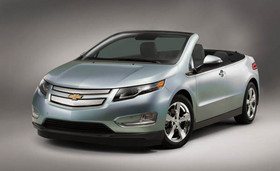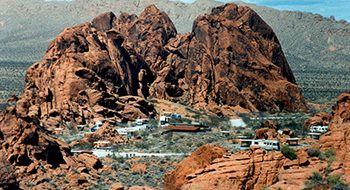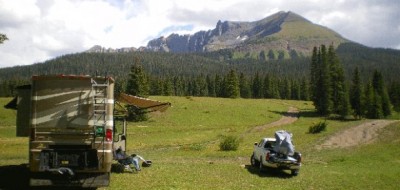By Bob Difley
 A lot of hype and optimism attach to press releases and news reports on not only the future growth of electric vehicles (inevitable) but also in what will be the jump start to propel them fully into the mainstream.
A lot of hype and optimism attach to press releases and news reports on not only the future growth of electric vehicles (inevitable) but also in what will be the jump start to propel them fully into the mainstream.
Though electric vehicle market saturation is only in the single digits, we hear a lot about the Nisson Leaf and Chevy Volt (photo), and it seems that every other automobile and light truck manufacturer – including dozens of start-ups around the world – are jumping on the bandwagon and trying to catch up with the market leaders.
For RVers, we can hope for development of electric dinghys that will re-charge from the main RV engine while towing or from a plug-in at campgrounds and public re-charging spots while on the road. Light trucks must have enough torque to pull a small trailer or carry the weight of a small motorhome. And of course, range and cost are currently the problems.
Hybrids, where you have the power and range of a supplemental gasoline engine such as in the Prius and Volt, are the logical interim step to full electric like the Tesla or Leaf. But they will not become a hit with most mainstream car buyers until a battery–or other energy storage system–can deliver on reduced size, lighter weight, lower price, and a range of at least 300 miles.
Progress is being made by research institutions such as Lawrence Berkeley National Lab (LAL) in Berkeley, California, and Oak Ridge National Laboratory (ORNL) in Oak Ridge, Tennessee. Examiner.com posted an article called Li-based Batteries Fueling U.S. Electric Vehicle Goals stating that,
Several future battery alternatives being investigated at LBL include lithium-sulfur and lithium-air, which have the potential to generate much higher energy densities than Li-ion technology; thus fuel electric cars for longer distances.
In short, the lithium–sulfur (Li-S) battery is a rechargeable galvanic cell, which is relatively light and having an internal density similar to water. Sulphur is also significantly less expensive of a raw material than lithium, which offers inherent cost advantages.
In comparison, the lithium-air (Li-air) battery is a battery chemistry that uses the oxidation of lithium at the anode and reduction of oxygen at the cathode to induce a current flow. Li-air batteries have a much higher energy density than conventional Li-ion batteries, since they utilize the oxygen in air, eliminating the need for a Li-air battery to store fuel (oxygen) at the cathode.
How long this will take to becoming a viable commercial solution is a guess at best, and include factors such as whether the new batteries are environmentally-safe to dispose of or recycle at the end of a minimum 15-year lifespan.
ORNL is working on a related battery also, the Examiner continues:
ORNL has been more focused on a key battery component, the anode, where electricity is extracted in the system. The anodes of most current commercial lithium batteries are composed of graphite, which is a form of carbon. However, scientists at ORNL incorporated a special form of the compound, titanium dioxide, into the anode instead, which significantly enhanced performance. In recent tests, at the same level of current, it took the ORNL battery only six minutes to be 50 percent charged; thus generating a five-fold improvement over a graphite-based lithium-ion battery in the same period.
ORNL’s new battery has the potential to be used in a plethora of heavy-duty applications, beyond just hybrid electric vehicles including power grids and energy storage systems for wind and solar power generators, and this institution believes the best-case scenario would thrust it onto the market within five years.
It is an interesting time as we develop electricity as a vehicle power source–6 minutes to recharge a battery to 50% is impressive–and ween ourselves off foreign (read OPEC) oil.
Check out my website for RVing tips and destinations and for my ebooks, BOONDOCKING: Finding the Perfect Campsite on America’s Public Lands (or for Kindle version), Snowbird Guide to Boondocking in the Southwestern Deserts (Kindle version), and 111 Ways to Get the Biggest Bang out of your RV Lifestyle Dollar (Kindle version).



Lauretta Hartpence
I want to express my admiration for your kindness for persons who really want guidance on this particular matter. Your very own dedication to getting the message up and down had been particularly invaluable and has surely permitted regular people just like me to reach their pursuits. Your warm and helpful advice can mean a whole lot a person like me and a whole lot more to my mates. With thanks; from each one of us.
Ailene Tarbet
Thanks a bunch for sharing this with all of us you actually know what you’re talking about! Bookmarked. Please also visit my website =). We could have a link exchange agreement between us!
Rubie Kriegshauser
Hello! I simply wish to give a huge thumbs up for the nice info you will have here on this post. I will be coming back to your weblog for extra soon.
Margarete Girsch
You are a very intelligent person!
colon cleanser
I really appreciate this post. I have been looking everywhere for this! Thank God I found it on Google. You’ve made my day! Thank you again..
colon cleanse
I really wanted to make a simple comment so as to say thanks to you for these magnificent strategies you are sharing on this website.
Kathe Venter
Nice post. I be taught something tougher on totally different blogs everyday. It will always be stimulating to read content from other writers and follow slightly something from their store. I’d desire to use some with the content material on my blog whether you don’t mind. Natually I’ll offer you a link in your internet blog. Thanks for sharing.
Irene Ellingboe
It’s really a great and useful piece of information. I’m glad that you shared this helpful information with us. Please keep us up to date like this. Thanks for sharing.
sms lån utan inkomstkrav
I like what you guys are up to. Such intelligent work and reporting! Keep up the excellent works guys. I’ve incorporated you guys to my blogroll. I think it will improve the value of my site. 🙂
Abbie Elstad
You made some decent points there. I looked on the internet for the topic and found most guys will approve with your site.
Pingback: url
Barney
Actually, diesel electric systems are on the way… Very expensive yet. Some have 100 kW per wheel.
As far as Journey39n goes, I need more power. Conversion is 745 W per HP. Then add in losses. 15 – 20 HP isn’t going to get you up a hill.
Journey39n
For Tom S, and those of us who need our diesel pushers. The technology is already here, and in use on a large scale. The most efficient, high torque, load pulling mode of transportation on dry land, is the railroad’s diesel-electric locomotives.
As an bridge to full electric, why can’t electric motors be adapted to large RV’s, with an appropriate sized diesel generator, say 15-20kw, powering those motors. Milage could go up tremendously, 20-30mpg or more. Look up history, old Doctor Porche, in the early 1930’s put an electric motor on each wheel, and had a powerful 4 wheel drive car, running on the batteries of the time, it can be done.
Hybrid cars do similar things, but waste a lot of energy charging big battery packs. Just my soap box, here, but controlling emmisions on a smalle generator engine, seems to be something we can do right now. Make no mistake, we need better battery technolgy, but we can make more efficient RV’s now.
Fritz
The studebaker museum in South Bend Indiana, has a 1905 wagon that was converted to electric and could haul 2500 lbs. Yes folks, way back in 1905.
Great place to visit if you like cars. I think they were way ahead of their time. This museum is less than 20 miles from Elkhart, Indiana.
DA
Subsidies to Oil Companies should STOP $4B/year!
So should subsidies to Wind and Solar Companies $180B/year!!!!!!!!!!!!! STOP!!!!!!!
Look at how well the government ethanol subsidies are working – what a waste! STOP!
DOE’s Solyndra is just the tip of the iceberg… STOP!
STOP STUPID AND WASTEFUL GOVERNMENT SPENDING
DA
Based on sales of around 6,000 Volts this year and the $1.5B subsidy given to Gov Motors to develop and manufacture the Volt actual cost is $290,000 per car. Only well to do can afford these vehicles ($32,500 after $7,500 rebate) and the rest of us subsidize them to the tune of $257,500/vehicle… and we are complaining about public land leasing to oil companies? …and we are putting our trust in DOE at ORNL and LAL to save the day? The common denominator in all of these stupid transactions is a much to powerful and bloated central government. States must rise and take back their lands, to be managed more at the local level; natural gas is the bridge that should be pursued until other technologies can be developed by private sector without misuse of taxpayer monies; stop the stupid waste; this will stop OPEC control over petrol prices (report of oil exports exceeding imports is not correct).
hoppe
Here in Colorado, we watched the Grand Valley get over a thousand holes punched into it. They test pumped the wells, capped the wells and moved to the next drill site. When they got the field/valley drilled. they closed up shop, pretty much sending the Grand Junction Economy into the toilet. No trucks running the roads picking up oil from the tanks. Just shut down.
They picked up their toys and went to the Oil sands up next to Canada. Punching holes as fast as they can. Not producing the field, just punching holes. Getting ready to raise the gas prices to $4.50 this summer, according to AAA.
Alternate fuels are our only chance of retaining any economical means of transport for the future. We’ve lost control of our petroleum reserves already.
We need to quit supporting the Oil Companies and get with another program.
hoppe
The ‘Drill Baby Drill’ crowd are as mislead as can be. Saw on the news a week or so ago that the US Petroleum Exports, exceeded Imports for the first time in 2010…. And still we get these post about ‘If we’d just drill more holes’…
What a joke. How many landowners still hold the mineral rights to their land? NOT Many.
The Public Lands have been leased to oil companies; Mostly at very Favorable rates per acre. “WE” don’t own any oil. BP and the other companies own it. And they pump it as they see fit. NOT for our BENEFIT.
The oil companies are the people who are raising the prices,,, Not shortages.
Pay attention now class.
Jim H
I agree with Tom S as noted above.
butterbean carpenter
Howdy Bob,
What happened to the Winnebago Electric RV???
Tom S
The only way these cars are viable is to keep oil prices high. If we were to tap our own oil reserves we could break OPEC. These electric cars are dream of the environmentalists who are probably being funded by OPEC so that we don’t drill for our own oil.
These hyhbrid and electric cars are OK for TOAD’s but worthless to those of us that need oil for our diesel pushers, travel trailers and fifth wheels.
Until these vehicles can stand on their own, I object to the tax credit for buying one of these fire bombs.